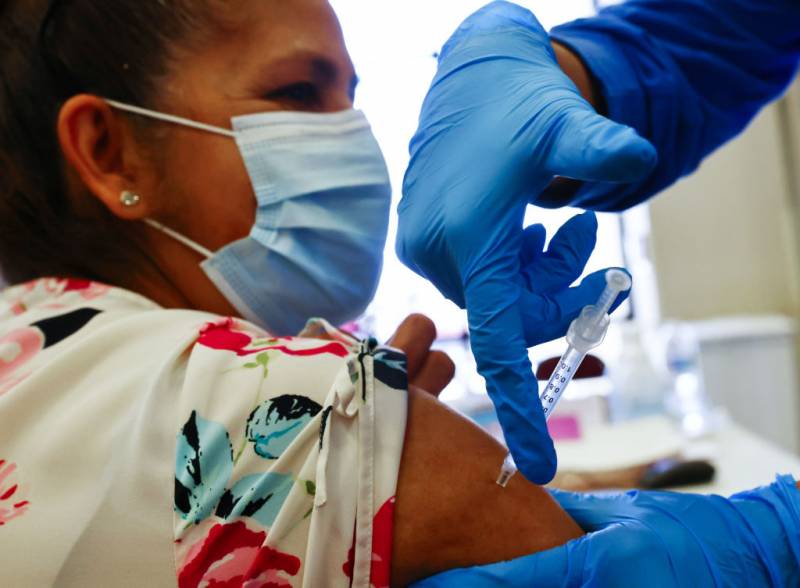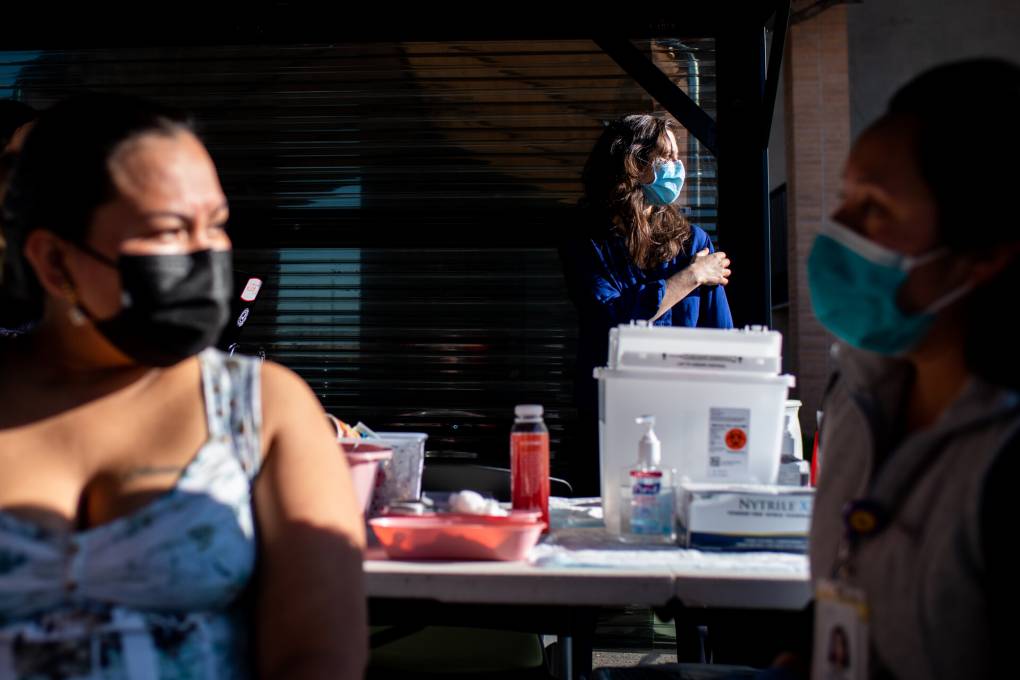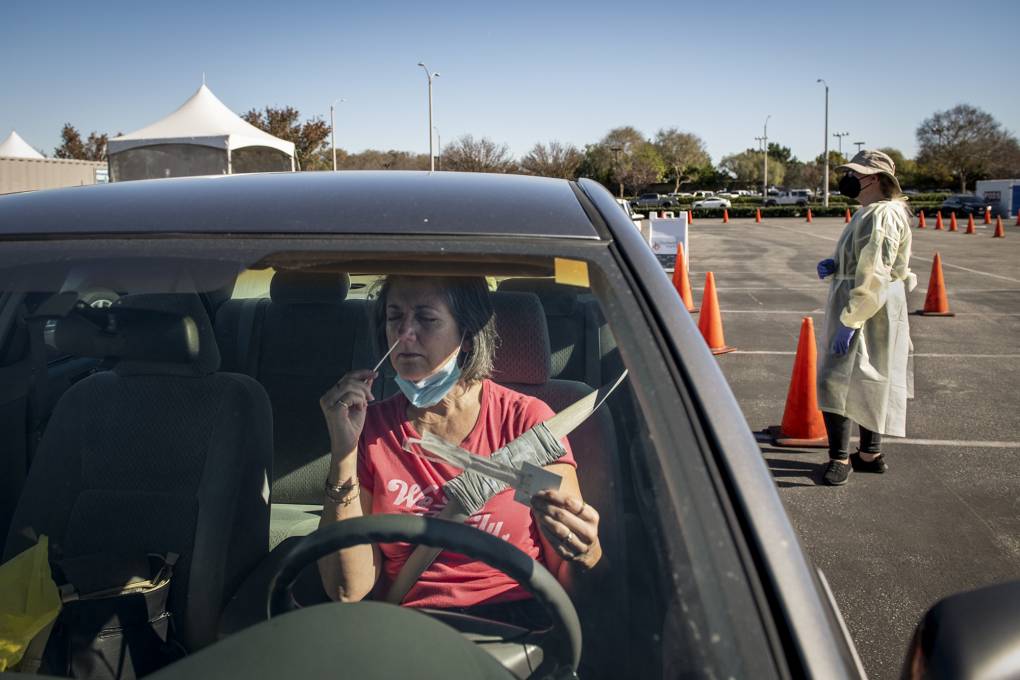Mangia said St. John’s also had to fight for vaccines, sending a letter to the state signed by 100 community organizations demanding the vaccine be sent to South Los Angeles after it had first been sent to UCLA and Cedars-Sinai instead.
The delayed payment is yet another blow to the fragile, but essential, health care system.
“I’m not a politician. I don’t pretend to be. But I’m disappointed,” Rossel said. “I’m hoping and praying that the state and the county look back and learn what was the best way to deliver vaccines and resources, and I’m hoping they have learned that the community clinics were one of the top-tier responders and they don’t forget about us again.”
The fallout at community clinics
Complicating matters, health centers are struggling with the same employee burnout that hospitals and private clinics have seen during the pandemic — but their margins are even thinner now.
“There’s a lot of fear around not having enough money to make it,” said Dori Rose Inda, CEO of Salud Para La Gente in Watsonville, which serves about 30,000 patients with lower incomes.
Salud Para La Gente saw precipitous drops in revenue during the first six months of the pandemic, when patients were told to avoid nonemergency care. The health center was only able to survive the past year with a $5 million American Rescue Plan Act grant, Inda said, but that money is all but gone.
“We literally pivoted everything to work differently during COVID,” Inda said. “Now as the grants are ending, we’re faced with … figuring out how to go full steam into primary and preventative care again and engage with people who are behind in the care that they need who may be sicker because of that.”
In Redding, at the Shasta Community Health Center, staff turnover has been high, with workers getting sick or burnt out. Also, about 10% left when the state vaccine mandate for health care workers took effect, CEO Dean Germano said. He has five times more job openings than normal.
“When you don’t have a supportive workforce, it really does impact your clinical efficiency and patient happiness, too, if they can’t get through the phone quickly or get an appointment when they want it,” Germano said.
Revenues haven’t bounced back, with patient visits still below pre-pandemic levels, particularly on the dental side, where the clinic sees only about half as many patients as before.
Shasta Community used some of its $5.6 million rescue grant to increase salaries to try to stay competitive, but most of it went toward breaking even on vaccine distribution, Germano said.
In Modesto, Angela Millan said staff turnover is so high and funding so limited that some clinics at Golden Valley Health Centers have not reopened.
“They told us there was not enough staff or providers. They’re saying there’s not enough funds for these clinics to reopen,” Millan said.
Millan, who handles patient scheduling, said every few months she’s told to remove a doctor from the schedule because they’ve left, leading to long wait lists.
A spokesperson for Golden Valley Health Centers said one clinic is closed for renovation and attributed staffing shortages to widespread lack of health care workers, not funding problems.
Long-term solutions needed for clinics
A bill introduced by state Sen. Bob Hertzberg, a Democrat from Van Nuys, aims to help alleviate some of the financial burden exacerbated by the pandemic by investing $400 million annually in community health centers to be spent on wages, workforce training and improved care.
He said the delayed COVID-19 vaccine payments are just one symptom of a long-standing funding gap for community clinics.
“Health care for millions of Californians is on the line if we fail to support our state’s community health clinics,” Hertzberg told CalMatters. About a third of the state’s 12 million Medi-Cal enrollees rely on community clinics for health care.
Employees at health centers make between 5% and 25% less than hospital workers, according to the Service Employees International Union, co-sponsors of Hertzberg’s bill. SEIU California represents roughly 14,000 health center workers.
“The wage gap is pretty significant,” said Joseph Bryant, president of SEIU 1021 in Northern California. “One of our clinics that we were recently able to get some substantial wage increases for, they were hovering just above minimum wage for many of the physician assistants, in the ballpark of $17 to low $20s.”
The state health center association also has made a budget request, asking for changes to be made in the way health centers are reimbursed, focusing on the value of services provided rather than volume.
Should either effort pass, workers say it could make a big difference.
Brisa Barrera, SEIU member and lead medical assistant at Santa Rosa Community Health, said two new medical assistants quit after three weeks because the workload was too much.
The churn is affecting patients, too. Some referrals for specialty care are four months old, and specialists have told the clinic they can’t take any more patients.
“There are patients telling me, ‘I don’t even bother calling the clinic anymore because the wait time for a live person to answer is over an hour.’ So treatments get delayed,” Barrera said.
She thinks about leaving herself sometimes, but as a former Medi-Cal patient, she knows it makes a big difference when patients see a face they recognize.
“My parents struggled because of translation, because of culture, because of their financial issues,” Barrera said. “These are patients that need access to care that don’t get the best care elsewhere. If I’m not here for my patients, who is going to take care of them?”
This story was updated to reflect that a source intended to say that physician assistants, not physicians, earn a certain wage. Also, this story was updated on March 21 with a comment from Golden Valley Health Centers.
CalMatters health coverage is supported by grants from the Blue Shield of California Foundation, the California Health Care Foundation and the California Wellness Foundation.



